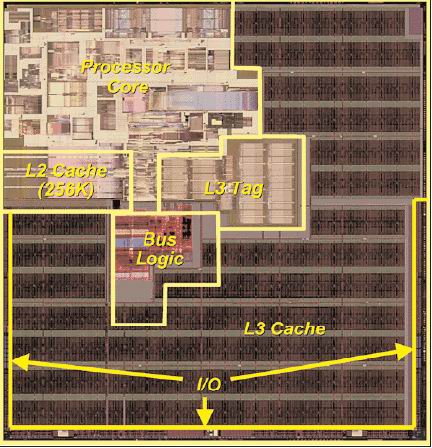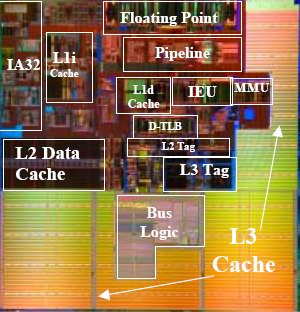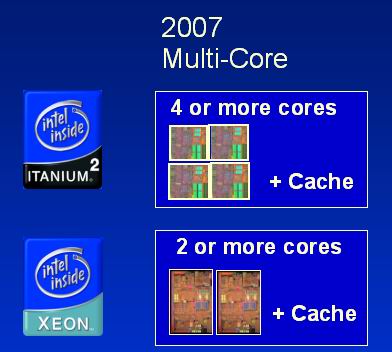Itanium - is there light at the end of the tunnel?
by Johan De Gelas on November 9, 2005 12:05 AM EST- Posted in
- CPUs
The limits of TLP...
Hardware engineers do not believe in massive superscalar CPUs anymore[2]. Increasing ILP a tiny bit requires exponentially bigger out-of-order hardware, which exponentially requires more power.
TLP and multi-core is hot and trendy. But the same problems that were true for squeezing ILP out of hardware are true about TLP in software. On the exception of naturally parallel applications such as rendering and database servers, getting more and more threads out of the majority of hardware will require exponentially more programming and debugging time. There are more high TLP designs such as Sun's Niagara that increase throughput, but also response time. And while the numbers of users that can update and read the database matters, the response time of the database can be important too. For example, while OLTP loads consist of many relatively simple SQL selects, Decision Support Systems (DSS or OLAP) fire off very complex queries with a high response time. To offer a good "data mining" experience, the single thread performance must not be neglected. The same can be said for some HPC and many typical workstation applications.
So, while designs that sacrifice ILP completely on the altar of TLP, such as Sun's Niagara, they may well be very popular in some markets such as webserving. Single thread performance is going to make the difference between the different multi-core solutions.
Here, the Itanium can leverage two big advantages: higher ILP and smaller cores. This last comment might seem ridiculous, given that the current Itanium Madison is about 432 mm2 large. However, if we look at the core (L1 inclusive), there about 25 million transistors that take about 80 mm2 die space. Note that the pictures below have been scaled and resized to reflect the relative proportions of the different cores.
Itanium: a slim figure
We compare the different CPU cores in the table below. We consider the L1-cache being part of the core, but we list the number of transistors separately to be clear. To keep it fair, we compare all CPU using the same process technologies, 0.13µ, with the exception of the Intel Xeon.
There is no doubt that a 0.13µ Xeon MP is no match for either of the IBM Power 5, the Itanium or Opteron with both Spec FP2000 and SpecInt around 1200 for a Xeon MP 3 GHz. The Xeon MP 0.13µ is also a 32 bit CPU, so it does not belong in the list below.
The reason why I listed the 90nm Xeon (DP) is to show how complex an x86 architecture can get when it has 64 bit and an extremely deep pipeline in a quest for high clock speeds, which must negate the low ILP. With more than 50 million transistors, it is no wonder that Xeon "Irwindale/Nocona" is the hottest CPU (per core) of the bunch despite being manufactured in a more advanced process.
Why do we use Spec FP2000 and Spec Int2000[3]? It is true that these benchmarks are close to meaningless when you want to compare server or workstation performance in the real world. Spec FP is a decent predictor of HPC/scientific performance, but fails to predict Digital Content Creation performance despite containing a few OpenGL benchmarks. The reason why we use these two benchmarks is that currently, we are evaluating the CPU architecture, its future potential and current compiler performance, and not the complete system.
* per core, two cores: about 70 million transistors
** for two cores
To calculate the cache sizes, we used the following formula:
HP and Intel have stated that the Itanium 2 core, including the L2-cache, has about 40 million transistors. If we subtract the L2 cache, we end up with about 26 million transistors, which still includes the x86 compatibility transistors (about 4 million) and the L2-tag. It wouldn't be fair to include the x86 transistors when we compare the merits of EPIC with x86 and RISC.
So, we end up with 20 to 22 million transistors for the core, which is truly remarkable for a CPU that is considered the fastest FP CPU out there (together with the Power 5), and is better than all the RISC players in Spec Int. The 0.13 micron Opteron (2.6 GHz) beats the best Itanium by about 10%; still is remarkable how good 20 million transistors can perform.
And, what about the Pentium M? Well, the core is about 25 million transistors, but it is pretty hard to compare this CPU with Itanium as the Pentium M is optimised for low power consumption. If we keep it fair and compare the two cores using the same process technology, the Pentium M isn't even close when it comes to performance. A 2 GHz Pentium M scores a respectable 1500 in SpecInt, but trails far behind with a specfp score of about 1000.
Hardware engineers do not believe in massive superscalar CPUs anymore[2]. Increasing ILP a tiny bit requires exponentially bigger out-of-order hardware, which exponentially requires more power.
TLP and multi-core is hot and trendy. But the same problems that were true for squeezing ILP out of hardware are true about TLP in software. On the exception of naturally parallel applications such as rendering and database servers, getting more and more threads out of the majority of hardware will require exponentially more programming and debugging time. There are more high TLP designs such as Sun's Niagara that increase throughput, but also response time. And while the numbers of users that can update and read the database matters, the response time of the database can be important too. For example, while OLTP loads consist of many relatively simple SQL selects, Decision Support Systems (DSS or OLAP) fire off very complex queries with a high response time. To offer a good "data mining" experience, the single thread performance must not be neglected. The same can be said for some HPC and many typical workstation applications.
So, while designs that sacrifice ILP completely on the altar of TLP, such as Sun's Niagara, they may well be very popular in some markets such as webserving. Single thread performance is going to make the difference between the different multi-core solutions.
Here, the Itanium can leverage two big advantages: higher ILP and smaller cores. This last comment might seem ridiculous, given that the current Itanium Madison is about 432 mm2 large. However, if we look at the core (L1 inclusive), there about 25 million transistors that take about 80 mm2 die space. Note that the pictures below have been scaled and resized to reflect the relative proportions of the different cores.

Madison 9 MB die

Madison core parts

Opteron die, rotated 90°
Itanium: a slim figure
We compare the different CPU cores in the table below. We consider the L1-cache being part of the core, but we list the number of transistors separately to be clear. To keep it fair, we compare all CPU using the same process technologies, 0.13µ, with the exception of the Intel Xeon.
There is no doubt that a 0.13µ Xeon MP is no match for either of the IBM Power 5, the Itanium or Opteron with both Spec FP2000 and SpecInt around 1200 for a Xeon MP 3 GHz. The Xeon MP 0.13µ is also a 32 bit CPU, so it does not belong in the list below.
The reason why I listed the 90nm Xeon (DP) is to show how complex an x86 architecture can get when it has 64 bit and an extremely deep pipeline in a quest for high clock speeds, which must negate the low ILP. With more than 50 million transistors, it is no wonder that Xeon "Irwindale/Nocona" is the hottest CPU (per core) of the bunch despite being manufactured in a more advanced process.
Why do we use Spec FP2000 and Spec Int2000[3]? It is true that these benchmarks are close to meaningless when you want to compare server or workstation performance in the real world. Spec FP is a decent predictor of HPC/scientific performance, but fails to predict Digital Content Creation performance despite containing a few OpenGL benchmarks. The reason why we use these two benchmarks is that currently, we are evaluating the CPU architecture, its future potential and current compiler performance, and not the complete system.
| CPU feature | Intel Itanium "Madison" | Intel Xeon P4 Irwindale | IBM Power 5 (+) | AMD Opteron |
| Process technology | 0.13 µ CU | 0.09 µ CU | 0.13 µ CU SOI | 0.13 µ CU SOI |
| Die Size (mm2) | 432 | 130 | 389 | 190 |
| Number of transistors (Million) | 592 | 169 | 276 | 106 |
| Number of transistors (Million) L1-cache | 1.8 | +/- 6 | 5.3 | 7.7 |
| Number of transistors (Million) L2 Cache | 14 | 113 | 107 | 57 |
| Number of transistors (Million) L3 Cache | 510 | 0 | off die | 0 |
| Number of transistors (Million) Tag (L2 + L3) | 23 | 4 | 33 | 4 |
| Number of transistors (Million) Core | 20 | 50 | 35* | 40 |
| Pure logic core (-L1) | 18 | 44 | 30 | 32 |
| Top clock speed | 1600 | 3800 | 1900 | 2600 |
| Best Spec FP2000 Score | 2712 | 1898 | 2839 | 1955 |
| Best Spec Int2000 Score | 1590 | 1810 | 1470 | 1713 |
| TDP | 107 W | 115-130 W | 200 W** | <95W |
** for two cores
To calculate the cache sizes, we used the following formula:
Cache size expressed in Bytes x 9 bits per byte (8 + 1 bit ECC/parity protection) x 6 Transistors per bit (SRAM)We calculated the Power 5 core as follows. The PowerPC 970FX, aka Apple's G5, is essentially a Power 4 core with Altivec, but without the L3 cache tag. If we subtract the number of transistors of the L2 cache (28 million) from the total number of transistors in the PowerPC 970, we end up with about 30 million transistors. The Power 5 core is a bit more complex (SMT and a few tweaks have been added), so we estimate it at about 35 million transistors.
HP and Intel have stated that the Itanium 2 core, including the L2-cache, has about 40 million transistors. If we subtract the L2 cache, we end up with about 26 million transistors, which still includes the x86 compatibility transistors (about 4 million) and the L2-tag. It wouldn't be fair to include the x86 transistors when we compare the merits of EPIC with x86 and RISC.

The Itanium core is twice as small as the Xeon's
And, what about the Pentium M? Well, the core is about 25 million transistors, but it is pretty hard to compare this CPU with Itanium as the Pentium M is optimised for low power consumption. If we keep it fair and compare the two cores using the same process technology, the Pentium M isn't even close when it comes to performance. A 2 GHz Pentium M scores a respectable 1500 in SpecInt, but trails far behind with a specfp score of about 1000.










43 Comments
View All Comments
ravedave - Thursday, November 10, 2005 - link
Who cares about TLP in the consumer space? Nothign can take advantage of it, HT showed that. I think whoever comes out with the best individual core next will do some sweet buisiness...eastvillager - Thursday, November 10, 2005 - link
That train is Opteron. All aboard!Itanium had a window where it could've shown, Intel missed it by a mile. Well, on the bright side, they killed HP's Unix Server business at the same time. I remember when HP announced they were stopping r&d on new PA-RISC processors and were switching to Itanium.
ElFenix - Thursday, November 10, 2005 - link
the story of how intel killed it for a processor that was about a a decade and a half, if not more, ahead of its time? and mostly because it wasn't invented at intel, but rather was bought as part of the dec compaq hp debacle (ooo, inept management again!). that was about the most promising processor on the planet for a while, but now its buried.Zebo - Thursday, November 10, 2005 - link
Wow Johan I don't even care about Itanium but your prose kept me all the way through. :) Excellent write up.WhoBeDaPlaya - Wednesday, November 9, 2005 - link
Interesting read, especially after having just talked with two engineers from the Itanium team (they were from the HP side) at Fort Collins. *Keeping fingers crossed for career prospects there* :DMatthias - Wednesday, November 9, 2005 - link
"The Itanium is also wider than the competition, which results in bigger benefits from threading techniques."I don't buy that. Current Montecito's implementation of TLP only uses "Switch-on-Event Multithreading" which is a another name for Course Grain MT. At any specific time there is only one thread being executed per Montecito core. How can then a wider cpu benefit more than a more narrow cpu? You cannot use the unused execution units with instruction from another thread. So, where is the advantage of having more execution units available?
The multithreading approach in Montecito helps hiding latencies but not doing more in parallel. You can't execute two instructions from different threads at the same time! The P4 can do so, although its capabilities in parallel instruction execution is limited by its rather narrow design.
Of course, we are talking about one specific EPIC implementation. Nobody can't guarantee that with the next EPIC microarchitecture there will be an SMT in favor of a SoE-MT implementation. In this case the above statement would be correct, although I doubt that we will ever see an SMT implementation for Itanium. The static instruction issue used in Itanium does not fit very well with the rather dynamic issuing introduced with SMT.
IntelUser2000 - Wednesday, November 9, 2005 - link
SoEMT hides memory latency, which is in a way taking advantage of increased ILP Itanium has since memory latency may limit the benefit.Also, it seems the performance among various apps vary as MUCH as opinions about the chip vary :). Some people really like it, while some hate it.
About the performance, I can't find the link. There was an IDF presentation on PC World(found by google) and showed relative Montecito performance. It was around 20% faster per clock in integer, but they were very ambiguous about it. Citing MT, higher frequency, more cache, and dual cores. But for all that, 20% is so little. There was another IDF presentation about Foxton Technology, and showed Montecito benchmarks on TPC-C, which from numbers was almost 25% faster at same clock, half the sockets(same number of cores) and same platform.
Intel and HP usually introduce better compilers at the same time, so I think its reasonable to expect 20-25% per clock. One other significant improvement on Montecito will be that it will have another shift unit, making the total two, along with others like more instructions and some little improvements here and there.
Montecito has x86 compatibility unit taken out, using the software based IA32-EL.
IntelUser2000 - Wednesday, November 9, 2005 - link
Itanium 2 Madison cache latency:32KB L1: 1 cycle
256KB L2: 6 cycles
9MB L3: 14 cycles
Montecito:
32KB L1: 1 cycle
1MB L2I, and 256KB L2D: 6 cycles(same as Madison)
24MB L3: 14 cycles(same as madison)
stephenbrooks - Wednesday, November 9, 2005 - link
I like this bit.--[HP and Intel have stated that the Itanium 2 core, including the L2-cache, has about 40 million transistors. If we subtract the L2 cache, we end up with about 26 transistors,]--
fic - Wednesday, November 9, 2005 - link
http://www.pasemi.com/">http://www.pasemi.com/These are PowerPC chips, but not from IBM. From the website: "dual-core device, operates at 2GHz with typical power dissipation in the range of 5 to 13 watts". According to articles SPECint is >1000 per core and SPECfp >2000 per core.